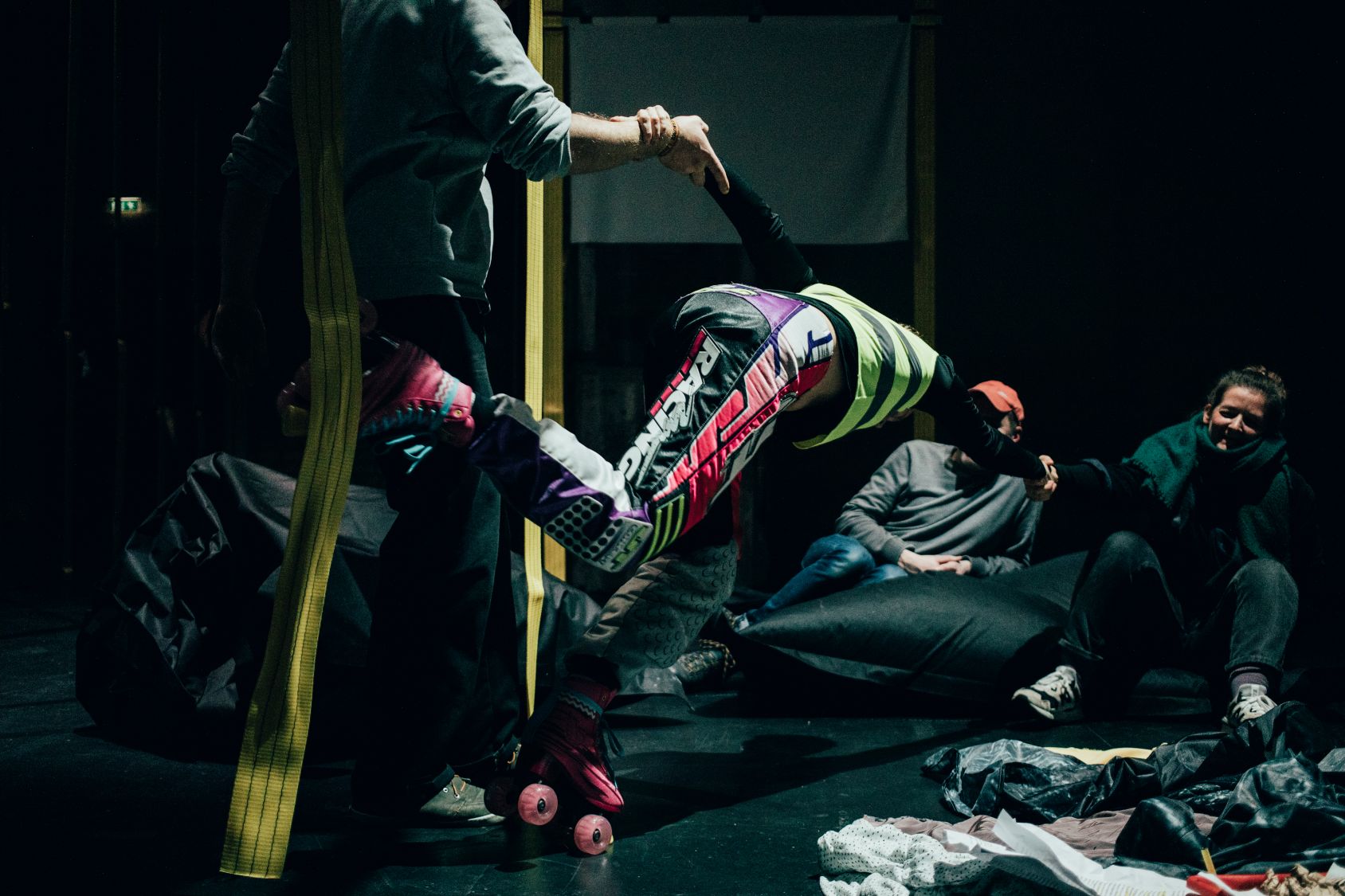The mountain
In the middle of the stage, among yellow belts hanging from the ceiling, between maps painted on transparent PVC, images, refrigerators and a hanging container, surrounded by spotlights, people and thoughts, there is a mountain made of papier-mâché. It is about one meter eighty high and its diameter measures more than two and a half meters. The mountain is painted with gray and white paint, a bit like an old oil painting. It is at rest, standing there silently, so that you almost do not notice it. What meaning does it carry?
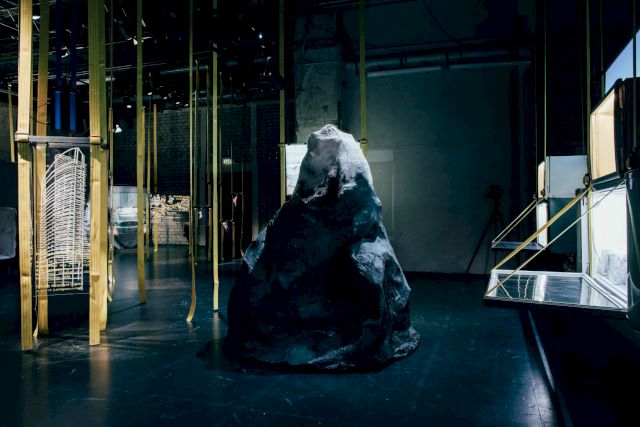
After a while, the mountain awakens. It is, at first, as if something inside of it started to vibrate. The mountain makes sounds, in the beginning only tentatively, then a little more clearly. It seems to send auditory signals. Slowly, the vibrations from its interior reach its skin. It begins to vibrate and pulsate. It crackles and rustles.
Finally, the mountain begins to move. Its top grows ever so slightly. It seems as if it begins to float and, guided by a magical hand, glides across the stage floor. The mountain spins around itself a little, and tests movements in different directions. Its movements oscillate between disorientation and purposeful locomotion. Occasionally, it hits the hanging stage elements, so that suddenly, its skin seems vulnerable and permeable.
As the mountain moves across the stage, it incessantly communicates with its surroundings. It tones and turns, twitches and steps. It seems as if the mountain wants to address, enchant and reassure its environment. The people around it make room for it. Some want to provoke the mountain, despite its age and peaceful appearance, and block its way. Finally, however, the mountain finds a new place.
From Crete, it has moved towards Beirut. Mount Ida has become Mount Lebanon, or one of the big garbage mountains on the coast of Beirut. It sends out some last signals so that it may find its place on the dump, next to the white container. And from the mountain something new hatches.
The Mourner
Slowly and fluidly, a figure peels out of the papier-mâché dummy. It seems to be born from the belly of the mountain, or – like a small river – to flow out of it. The figure wears a striking motorcycle pants with white, black and pink prints. The word RACING is printed in large white letters above her tailbone, an obvious contradiction to the calm, almost meditative quality of her movement. Her upper body is clad in black and she wears a black veil over her head, concealing her facial features.
From a folded position on the floor, the figure slowly begins to orient herself. On her hands and knees, she keeps looking for signs. With her fingertips she drums lightly on the dance floor, tracing imaginary lines below the surface, turning around her own axis. It seems as if she was a stranger in this place, but in contact with subterranean forces.
The dancer wears a veil that covers her face. It gives her a fragile, yet uncanny appearance. The fact that her face is covered seems to protect the figure and make her vulnerable at the same time. The spectators do not know whether they are seen by the dancing figure, whether the dancer can orient herself or is blind herself. Thus, another modality of seeing and sensing is at work here than rational and navigational overviewing.
An important reference for the mourning dance of Maria F. Scaroni is the short film ‘Stendali’ by Cecilia Mangini. The movie deals with the central question of Scaroni's work: How can mourning be contained and find a form? For only in so far it becomes, may mourning become expressed and held.
Mourning dance
The performer is the Italian artist Maria F. Scaroni – a choreographer, dancer and teacher living in Berlin. I invited her to develop a danced response to the collected research material part of the research project 'The Great Report'. Throughout the research process, the team and I tell Maria about our travels and experiences. She first takes in information and events, feelings and questions and then processes them in relation to her own movement repertoire. In this way, our stories become the basis of her performance
It seems as if my invitation to Maria is an impossible and contradictory one. After all, how can the entire density of information from the research to be danced? What can dance do in the face of the sheer mass of collected bits of information, acts of violence and stories? Yet, by inviting her to develop an autonomous dossier in the medium of dance, I follow an intuition that proves productive:
My own position as initiator of a research project that deals with logistics as a destructive form of choreography of commodities and white privileges within a neo-colonially and imperially structured world is fragile and problematic. Mere documentation and mapping of violent conditions in Nigeria, Lebanon, and Crete does not constitute a legitimate artistic response to questions of climate justice, colonial continuities, and my own ongoing entanglement in structures of exploitation and destruction.

At the same time, I am confronted with feelings of powerlessness, guilt, and shame. Why is it that I give myself the task of drawing a picture of my own entanglement in global economic cycles and, thus, my complicity in the ongoing disenfranchisement of people, the exploitation of resources, and the destruction of the planet? Who and what does this help?
While my own position seems more and more problematic to myself during the rehearsal process, Maria F. Scaroni succeeds in creating a space of bodily processing and danced mourning, in which the collected research materials are digested, and where, at the same time, a gentle but emphatic desire for liveliness finds expression.
Dance thus has a special role to play in the fabric of the research project: it opens up a place of affectation, emotional digestion, and excessive physicality that manages to walk the fine line between mourning and exuberant aliveness. Whereas the narrative reproduction of violent relations sometimes has a paralyzing character, the dance within the Great Report opens up a place for emotional work on one's own powerlessness and entanglement.
In order to be able to produce this space, Maria repeatedly invokes different figures and characters from her long dance career. In addition to the mountain and the mourner, the figure of the fool is central.
The fool
After the dancer tries to orient herself on the floor, she carefully begins to rise. Because she keeps rearranging her limbs in different spatial directions, she seems to be standing on shaky ground. Like a harlequin, Maria F. Scaroni assumes different a-symmetrical forms, so that her body begins to resemble the figure of the fool. Circling around herself, she moves through the audience, as if in an ancient ritual on the summit of yet another imaginary mountain. Her dance resonates with an underlying, eerie sadness.
Within the tarot, the fool is the beginning of the so-called Major Arcanas that symbolize a spiritual journey. On classical depictions of the card, you see a young man dancing, holding a rose in his hand and looking upwards to the ceiling. He seems insouciant and happy, and is accompanied by a dog. All the while, the fool dances next to an abyss, who he seems to ignore.
Throughout this first dance improvisation, in which she uses the method of ‘Authentic Movement’, she seems to invoke upon other bodies besides her own visible body. These other bodies may be our ancestors, they may also be the spirits of the people we have met on our research. Slowly, Maria F. Scaroni thus moves from Beirut towards Lagos.
On one of the lattice boards of the installation representing our findings from Nigeria she then, seemingly by chance, stumbles upon a glass container with which she begins to play.
Glasses, containers and logistics
Next, out of a supposedly blind gesture, Maria wraps herself in one of the large flags next to the grid table, on which a photograph from Nigeria is printed. Using this flag as a handle, she explores the installation. In the process, she finds a kind of jar. She begins to play with the jar on the grid table, producing heavy, rattling noises, while at the same time water or oil seem to drip from the large music system in the room. In the process, the glass almost escapes her control, as if it were itself animated by invisible forces.
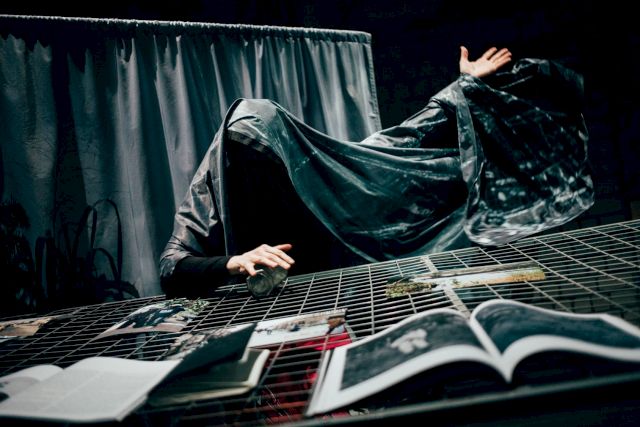
When she opens the glass, birdsongs escape from it, which then slowly begin to change into a techno soundtrack. The meaning of the glass oscillates. At first it may appear as Pandora's box from which evil has escaped into the world: greed, violence and our hypocritical apathy towards this violence. It is thus perhaps also a metaphor for the impossibility of containing the power of oil, which in Nigeria, and elsewhere on the planet, is often extracted under questionable political and environmental conditions. The dark spirit of greed and acceleration can no longer be controlled or contained.
With a flag as a mourning cloth or skirt, the dancer then conjures up a kind of altar, above which floats a large PVC sheet with advertising slogans from logistics companies. The glass is placed on the table while Maria puts on a white wig, which reappears later in the performance. In its function as a container, the glass thereby also refers to the activity of logistics and, indirectly, to the technical device of the shipping container. In an ambivalent gesture, Maria F. Scaroni seems to simultaneously celebrate and mourn the logistical activities of packaging, shipping, and marketing.
Telephone call and mourning song
After this dark, sinister evocation of the logistics altar, the glass is once again used in a very different way, that is, as a false theatrical prop: It seems to become a telephone receiver, insofar Maria both holds the glass to her ear, but also uses it as receiver into which she speaks. She speaks into the glass in a kind of unintelligible gibberish, reminiscent at once of funeral dirges, Internet communication, and exuberant reports from abroad.
As she alternates between crying and exuberant joy, Maria F. Scaroni begins to sing into the glass. By repeatedly changing its position on her mouth, she intones a mysterious dirge, accompanied first by more birdsong and then by Katerina Pelosi's music. In this way, the glass becomes a storage vessel for the mourning of our complicity in the global choreography of logistics.
At the same time, the glass bespeaks of another form of storytelling: In her ‘Carrier Bag Theory of Fiction’, writer Ursula K. LeGuin evokes such an alternative by way of describing the simple opposition between bag and spear: Stories, she writes, can function like weapons, in that they are constructed toward a lethal climax or turning point. Or they can serve the collection of small or large experiences, not pointed, charged, dramatized from the outset. How can we tell report differently, the glass thus seems to ask, about the violent conditions in which we live and for which we are jointly responsible?
Nothing personal
Another way of telling connections across continents appears around the middle of Maria F. Scaroni's performance. On her hands and knees, she first moves back to the starting point of her performance, to the place where the papier-mâché mountain originally stood. Underneath the mountain, a pile of debris had remained, onto which Maria now sits down: an inflatable plastic unicorn, pink roller skates, and some texts printed on A4 paper
With a kind of bird whistle, Maria lures the entire audience closer to the small pile of trash. Then, she grabs some papers lying around there and begins to read a passage from the text ‘Nothing Personal’ by James Baldwin, published in 1964 in collaboration with the photographer Richard Avedon. Maria delivers the text in a soft, approachable voice, personal and intimate, as if telling a bedtime story. She addresses the audience directly, establishing a moment of connection:
Pretend, for example, that you were born in Chicago and have never had the remotest desire to visit Hong Kong, which is only a name on a map for you; pretend that some convulsion, sometimes called accident, throws you into connection with a man or a woman who lives in Hong Kong; and that you fall in love. Hong Kong will immediately cease to be a name and become the center of your life. And you may never know how many people live in Hong Kong. But you will know that one man or one woman lives there without whom you cannot live. And this is how our lives are changed, and this is how we are redeemed.
What a journey this life is! dependent, entirely, on things unseen. If your lover lives in Hong Kong and cannot get to Chicago, it will be necessary for you to go to Hong Kong. Perhaps you will spend your life there, and never see Chicago again. And you will, I assure you, as long as space and time divide you from anyone you love, discover a great deal about shipping routes, airlines, earthquake, famine, disease, and war.
At the same time, the text represents a commentary on the function of global logistics, which, beneath its total commercialization and its fanatical striving for efficiency, can be read as a form of connection and commitment, and thus as a potential for love. A suchlike direct mesh of bodies is also the subject of the following part of the performance. In order to prepare, Maria F. Scaroni puts on the pink roller skates that are lying on the small pile of garbage.
Parcel and deliverer
Very carefully, as if she had never stood on roller skates before, Maria begins to stand up. As she does so, she seeks physical connection with the people sitting around her. She uses them to help her stand up and find her balance. Time and again she almost falls down, but grabs a stranger's arm or shoulder at the very last moment. She plays the crazy dilettante.
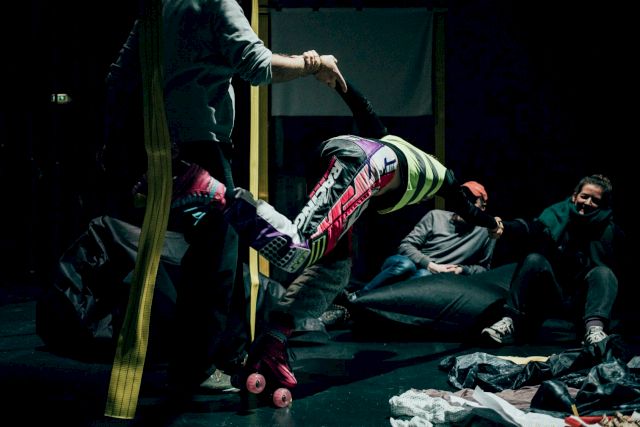
After a while, she breaks up the game and begins to explore the entire room. It now becomes clear that she is very good at roller skating. The room turns brighter and Maria performs tricks: She comes to stand in front of people very suddenly, flirts with them, and takes their arms to be pulled in a new direction with great momentum. She herself becomes a package that is sent back and forth between the audience, creating loose connections between the people in the audience.
Throughout this part of the performance, the sounds of the roller skates on the stage floor are very present. They are strongly reminiscent of the sound of wind, which is picked up and amplified on the musical level of the performance.
Ritual structure
The sound of the wind, but also the sound of water, which can be heard again and again from the stage sound system, and which also keeps dripping from a small installation on stage, can be read as an allusion to the four elements which give an implicit structure to Maria F. Scaroni's performance.
This structure is reminiscent of a ritual: the first chapter of this mourning and life ritual has been dealing with the element of earth and the question of belonging and stability. It is connected to the figure of the mountain and the research in Beirut in which we had dealt with land reclamation projects made of garbage.
The second chapter is oriented around the element of fire and connected to our research on the oil economy in Nigeria. Throughout this chapter, Maria alternates, in rapid succession, between different bodily states: Crying and laughing, anger and sadness. This is followed by a short chapter on the element of water, which is placed below the large screen and station about the research in Crete. With her flowing, soft voice, Maria practices a small form of communion by reading James Baldwin's text, which in turn points to the multiple global connections created by waterways.
Finally, we have arrived at the chapter on the element of air, which is about the exchange of information and invisible data structures. Here, Maria becomes a package, a traveler within the fiber optic cables. At the same time, she weaves a fine web of touches and glances between the people in the audience.

To end the ritual, another figure appears, and Maria speaks a final, highly ambivalent text:
We move mountains / Ciccolina
Now, the roller-skating dancer circles around the previously ambivalent and darkly charged logistics altar (the altar of the DJane, the site of the control panel and overview position). Before she starts her big, ironic advertising speech, for a moment, she quotes warm-up exercises as they are performed for and with workers in Amazon distribution centers. These can also be seen on a screen above her.
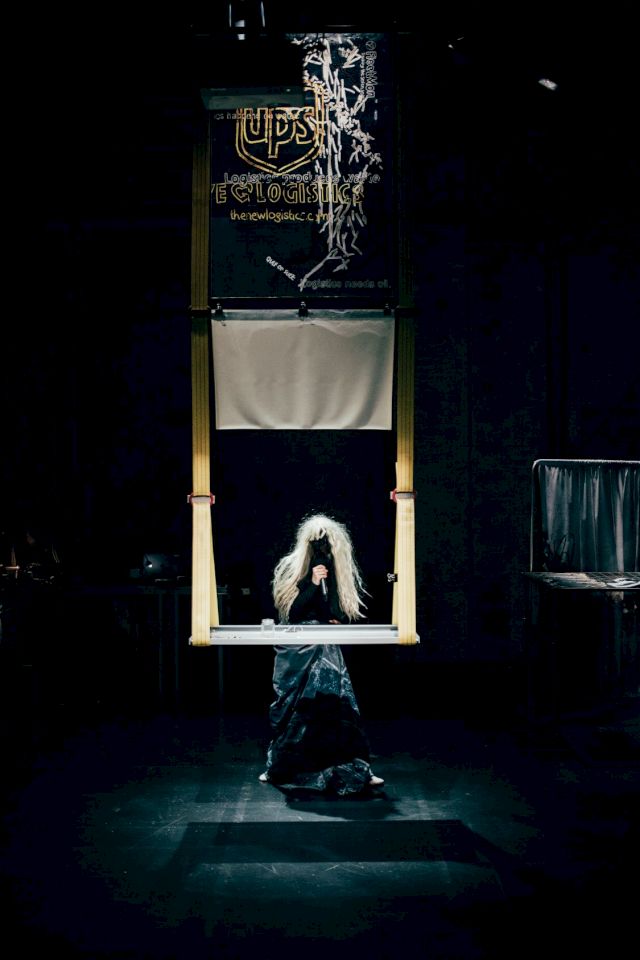
At the same place where the small mini-rave had taken place before, where the Pandora's glass box had been placed, Maria, still on roller skates and wearing the blond wig she had worn before at her mini-rave, now speaks an advertising text from Maersk Moller (reproduced here only as an excerpt). She wears headphones, so that she seems to be remote-controlled, and recites the following sentences:
The world’s population is exploding, along with the demand for food, energy, and millions of other goods. The challenge is to satisfy this mountainous demand whilst leaving the smallest food-print possible. Ironically, the smallest food-print is often made by the biggest shoe. Size and scale are simply too efficient, both for business and the environment. To Maersk, the whole difference is in the details, and this is how Maersk moves mountains.
Size gives flexibility, the flexibility to match the right vessel to the costumers need. The flexibility to redirect cargo while still in transit, without hesitation. Size leads to greater efficiency, too. An expanding fleet is a modern fleet. Maersk Line is the world’s largest shipping company, each day moving mountains of goods from one side of the globe to the other. To Maersk this is obvious: Size matters. Hard proof that big is beautiful.
To position herself in relation to the patriarchal, sexist undertone of this advertising text, Maria F. Scaroni first speaks it as if it were both a pornographic instruction and a speech by a CEO to her shareholders at the same time. In terms of her tone, physicality, and appearance, Maria thereby cites the character of Ciccolina, an Italian soft-porn actress who turned into a politician.
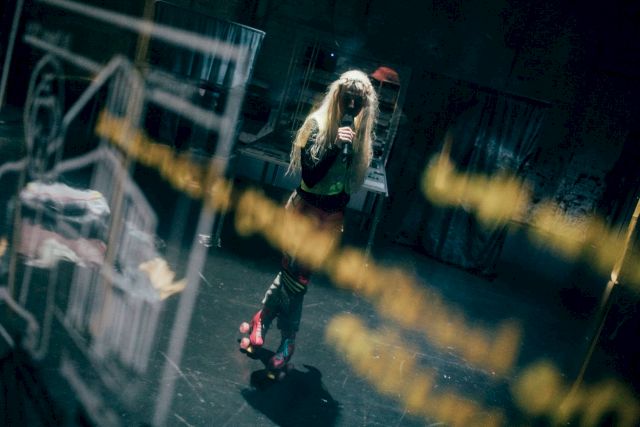
As she speaks, Maria's voice breaks more and more. She becomes quieter, more approachable, more vulnerable. At the end of her approximately 30-minute solo performance, a specific image emerges that is full of ambivalences: Is someone speaking here who is in control, who manages and optimizes movements, or someone who is subject to these movement imperatives? How can we mourn our ongoing complicity in exploitative, neo-colonial supply chains when they simultaneously keep us alive? Who can we accuse when we ourselves are complicit?
Then, Maria leaves the room through a large double door, and, for a moment, the lights go out. I imagine: the oracle has spoken.
Dance as oracle
If dance were an oracle, it would evoke ambivalent feelings. It would return an affective dimension to the space of rational knowledge and confront us with the necessary multipolarity of the living, with the felt fact and the felt sense that aliveness always contains both joy and sorrow.
If dance were an oracle, we would not read the future in it, but we could learn something about how to better bear our present, about how to better live with the knowledge that we are always already intertwined with our socio-technical environment, with the knowledge of our fundamental dependence on other bodies, human and non-human.
If dance were an oracle, it could not be choreographed. Rather, it would be opposed to the choreography of logistics. Where the latter mobilizes precisely measured individual parts along predetermined pathways, dance were to speak out of the improvised necessity of an ongoing processing and digestion of our own situatedness. It would then not move mountains, but from within mountains. It would move from a tangle, or mountain, of relations.



